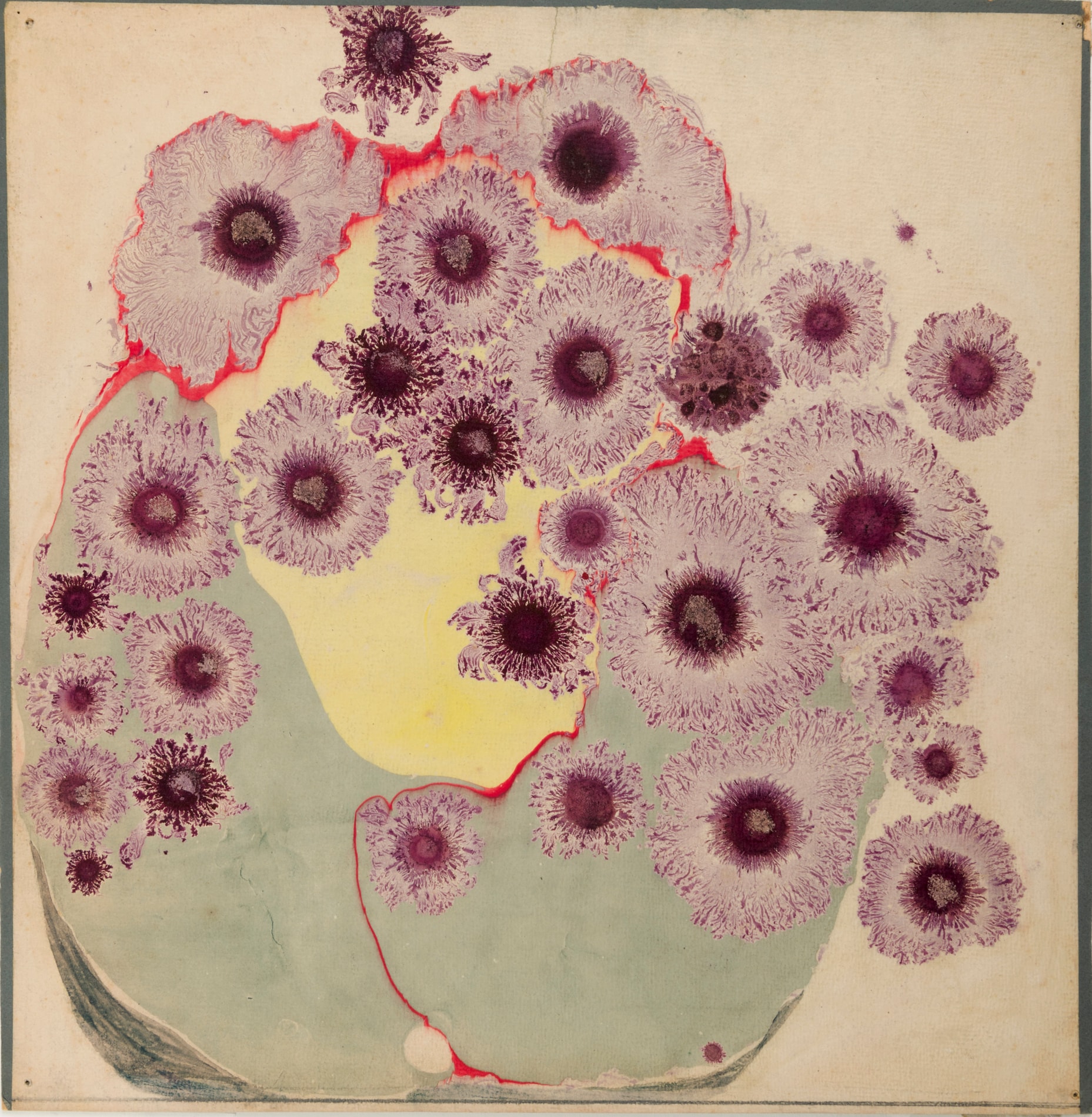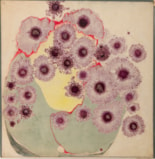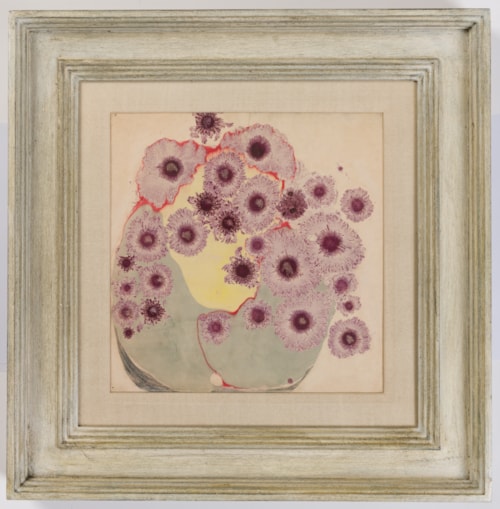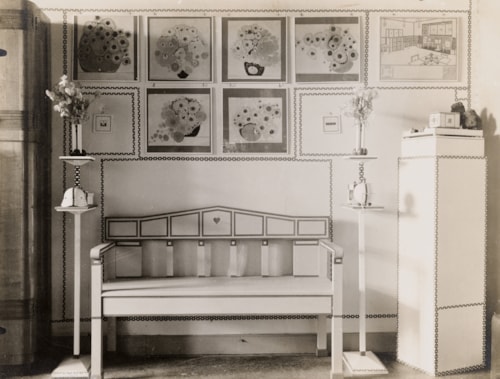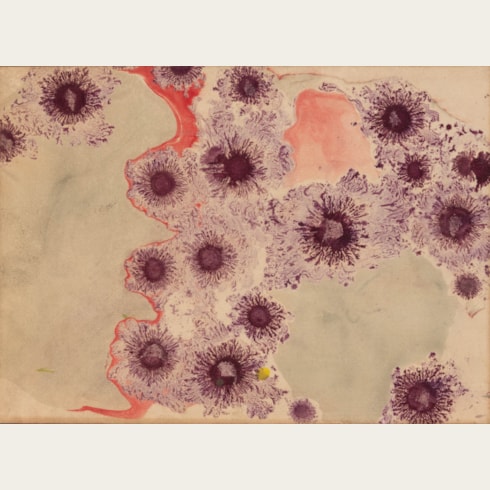Emil PIRCHAN
(Brno 1884 - Vienna 1957)
Composition in Mauve, Green, Orange and Yellow
Sold
Watercolour and grey wash, with a lower framing line in pencil, on buff paper laid down (by the artist) on a thin board.
345 x 334 mm. (13 5/8 x 13 1/8 in.)
ACQUIRED BY THE J. PAUL GETTY MUSEUM, LOS ANGELES.
345 x 334 mm. (13 5/8 x 13 1/8 in.)
ACQUIRED BY THE J. PAUL GETTY MUSEUM, LOS ANGELES.
This large sheet is among a group of drawings by Emil Pirchan, produced around 1907, using a sort of marbling technique that he seems to have invented. Hanging alongside several other works on paper of this distinctive type, this Composition in Mauve, Green, Orange and Yellow is recorded (at the upper left) in a 1907 photograph of the hallway of Pirchan’s home in Brno, for which the artist designed all of the furnishings. Two similar works are in the Steffan/Pabst collection in Vienna.
One of the most creative and prolific artists of his day, working mainly in Munich, Berlin, Prague and Vienna, Emil Pirchan was active as a designer, scenographer, commercial graphic artist, costumer, book illustrator and architect, as well as a writer and teacher. Born in the Moravian city of Brno, in what is today the Czech Republic, he was a pupil of the Austrian architect Otto Wagner at the Academy of Fine Arts in Vienna. He was also much influenced by the work of his second cousin Joseph Hoffmann, an architect and designer who was a founder of both the Vienna Secession and the Wiener Werkstätte. He began his independent career in Brno, where he worked as a drawing teacher, before moving in 1908 to Munich, where established a school for graphic design and applied arts. He undertook several projects for interior decorations, and also produced a number of drawings for architectural projects, which were strongly influenced by the example of his teacher Wagner. In 1912 an exhibition of fifty of his set designs was held at Heinrich Thannhauser’s Moderne Galerie in Munich, and five years later he was appointed director of set design and costumes at the Bavarian State Theatre. Also in 1917, exhibitions of his work were held at the Landesgewerbemuseum in Stuttgart and the Museum August Kestner in Hannover. Pirchan worked in Munich for thirteen years, winning several prizes in national and international competitions.
In 1921 Pirchan moved to Berlin, where he worked as a scenographer at the State Theatre and oversaw numerous productions. He won a gold medal in the category of set design at the International Exposition in Barcelona in 1928, and in 1930 produced futuristic designs for a theatre in South America, a project about which little else is known. In 1932 Pirchan settled in Prague, working as the head of set design at the German Theatre. In 1936 he returned to Vienna, where he was to live and work until his death. He was appointed a professor at the Vienna Academy of Fine Arts and served as director of the newly-established school of set design there, while providing set designs for productions at the Burgtheater and the State Opera.
Throughout his long and successful career Pirchan produced numerous designs for posters, advertisements, furniture, jewellery, arts and crafts objects and fabrics. In addition, he was a novelist and playwright, and published several books on art and artists, including one of the first biographies of Gustav Klimt. The full range of Pirchan’s oeuvre was only relatively recently brought to light in a retrospective exhibition held at the Museum Folkwang in Essen and the Leopold Museum in Vienna between 2019 and 2021, which established him as a leading figure of Central European Modernism. Much of the exhibition was based on an archival collection of his work that was recently rediscovered in a box in an attic in a house in Zurich.
In 1921 Pirchan moved to Berlin, where he worked as a scenographer at the State Theatre and oversaw numerous productions. He won a gold medal in the category of set design at the International Exposition in Barcelona in 1928, and in 1930 produced futuristic designs for a theatre in South America, a project about which little else is known. In 1932 Pirchan settled in Prague, working as the head of set design at the German Theatre. In 1936 he returned to Vienna, where he was to live and work until his death. He was appointed a professor at the Vienna Academy of Fine Arts and served as director of the newly-established school of set design there, while providing set designs for productions at the Burgtheater and the State Opera.
Throughout his long and successful career Pirchan produced numerous designs for posters, advertisements, furniture, jewellery, arts and crafts objects and fabrics. In addition, he was a novelist and playwright, and published several books on art and artists, including one of the first biographies of Gustav Klimt. The full range of Pirchan’s oeuvre was only relatively recently brought to light in a retrospective exhibition held at the Museum Folkwang in Essen and the Leopold Museum in Vienna between 2019 and 2021, which established him as a leading figure of Central European Modernism. Much of the exhibition was based on an archival collection of his work that was recently rediscovered in a box in an attic in a house in Zurich.
Provenance
The estate of the artist, and thence by descent.
Literature
Beat Steffan, ed., Emil Pirchan: A Universal Artist of the 20th Century, Wädenswil am Zürichsee, 2018, pp.158-159 (illustrated in situ in the hallway of Pirchan’s home in Brno in 1907).

